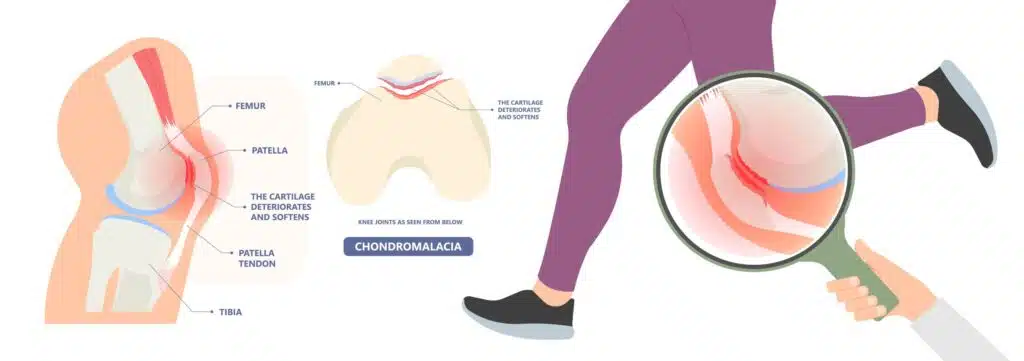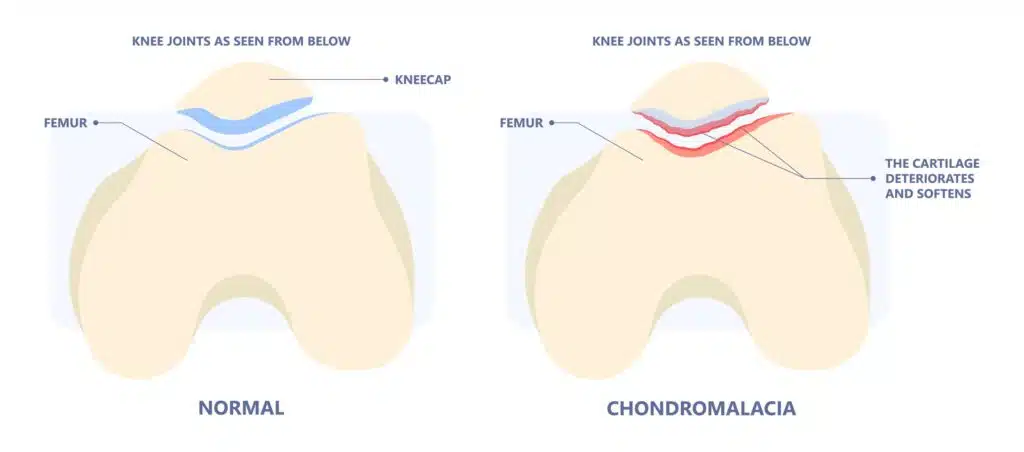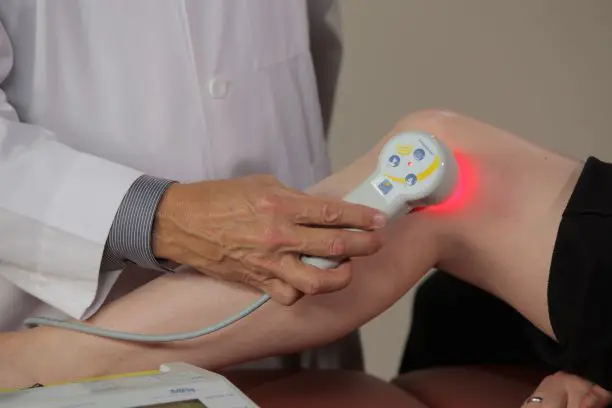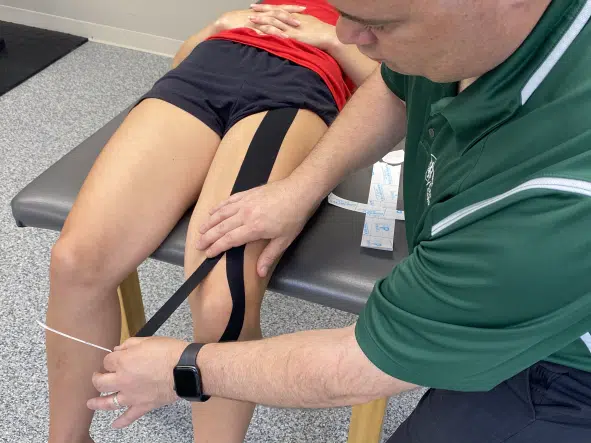Chondromalacia patella is a serious knee disorder that can cause severe pain and mobility issues if not treated properly. It occurs when the cartilage underneath the kneecap starts to break down, causing swelling, stiffness, and tenderness in the joint. The condition can be caused by trauma or overuse of the knee such as during running or sports activities. Other risk factors include obesity, poor muscle control around the knee, flat feet, and tight muscles in your hips or legs. If left untreated, chondromalacia patella can lead to chronic pain and even arthritis. Treatment should always be done with guidance from a healthcare professional who will create an individualized treatment plan based on your specific needs.

What causes chondromalacia patella?
Chondromalacia patella is caused by an imbalance in the muscles or ligaments that support the kneecap. This can lead to inflammation, swelling, and increased pressure on the cartilage underneath the kneecap. A weak vastus medialis muscle can cause a deficit in quadriceps strength which must be addressed to manage symptoms. This can cause it to become damaged over time. Common causes of chondromalacia patella include:
- Injury or trauma
- Overuse of the knee joint
- Weakness around your hips or legs
- Obesity
- Flat feet
- Muscle imbalances around your knee joint
Symptoms of Chondromalacia Patella
Chondromalacia patellae is a condition indicated by pain in the front of the knee. There can be tenderness when touching the inside or outside borders kneecap. There can also be creaking or crackling noises, known as crepitation, when bending the knee. Certain types of chondromalacia usually can affect young children and adolescents while degenerative forms are more common among middle-aged adults.
What makes chondromalacia patella worse?
Certain activities and movements can put additional strain on the knee joint, making the pain worse. Knee pain can be exacerbated by activities that load the patellofemoral joint such as running, stair climbing, squatting and kneeling. Activities that involve repetitive motions such as cycling or stair climbing should also be avoided if possible.

Chondromalacia Patella vs. Patellofemoral Pain Syndrome
Chondromalacia patella is closely related to patellofemoral pain syndrome (PFPS) and it is not always easy to tell them apart, but there are some differences. Chondromalacia is specifically referring to the cartilage underneath the kneecap, while PFPS includes a wide range of issues such as weak muscles, altered running gait and poor knee control. Chondromalacia patella usually affects one side of the kneecap while Patellofemoral Pain Syndrome (PFPS) generally affects both sides and it may also cause swelling in the knee joint while PFPS usually does not.
Chondromalacia Patella Arthroscopy
In some cases, chondromalacia patella may require surgery. Arthroscopy is a common procedure used to treat chondromalacia patella in which a small camera is inserted into your knee joint through several small incisions. This allows your surgeon to get an up-close look at your knee joint and make any necessary repairs. Arthroscopy is usually used for more severe cases and may be combined with other conservative treatments such as physical medicine or medications.
- Remove any damaged cartilage or tissue
- Smooth out rough areas of the kneecap
- Tighten or loosen ligaments around the knee joint
- Release tendons that may be causing symptoms.
The recovery time for chondromalacia patella arthroscopy is typically about four to six weeks, however, it can vary depending on the extent of your surgery and how quickly you can heal.
When does chondromalacia patella require surgery?
Surgery is usually only recommended for chondromalacia patella if your symptoms are severe and do not respond to conservative treatments such as rest, physical therapy, bracing or medication. It is important to speak with a healthcare professional before deciding if surgery is right for you.
Medications
Non-steroidal Anti-inflammatory Drugs (NSAIDs) can be an effective treatment option for chondromalacia patella, as they can help reduce inflammation and pain in the knee joint. Common NSAIDs include ibuprofen, naproxen and diclofenac. Steroid injections are a common treatment option, as they provide fast and effective relief of symptoms. These medications reduce inflammation in the knee joint, which can help alleviate pain and swelling caused by chondromalacia patella. Steroid injections may be used alone or in combination with other treatments such as physical therapy or medications. In severe cases where cartilage damage is already present, steroid injections may be necessary to repair any damaged tissue and prevent further degradation.

Conservative Treatments
In mild cases of chondromalacia patella, conservative treatments such as rest, chiropractic care, physical therapy and bracing can help reduce chondromalacia patella symptoms. Pain medications, corticosteroid injections and anti-inflammatory drugs may also be used to reduce inflammation and pain levels. These treatments are typically recommended before surgery is considered.
Rest is one of the most important treatments for chondromalacia patella. Resting helps reduce pressure and swelling in the knee joint, allowing it to heal from any damage that has occurred. It also gives your body time to adjust to any changes in activity level or lifestyle that may be causing chondromalacia patella symptoms. When resting, you should avoid activities such as running, jumping, squatting and kneeling which can put additional strain on your knee joint and make it worse. Additionally, try to limit activities that involve repetitive motions like cycling or stair climbing if possible.
Kinesio Taping can be an effective treatment option for chondromalacia patella as it helps to reduce pressure on the kneecap by providing extra support to the knee joint, allowing it to heal more quickly. Additionally, kinesiotaping can be used to prevent further damage to the cartilage in cases where chondromalacia patella has already caused some degradation of the cartilage. In milder cases, kinesio taping may be enough to alleviate symptoms while in more severe cases they may need to be combined with other treatments such as physical therapy or medications. Braces can also be purchased that can accomplish the same concept as taping.
Custom foot orthotics can have a hugely beneficial effect on chondromalacia patella, as they are an effective way to improve gait and reduce pain. Orthotics act as an external support system, helping to provide additional stability and motion control to the knee joint. This can help decrease inflammation and pressure in the knee, allowing for a more comfortable and pain-free movement.
Cold laser therapy is a non-invasive, painless treatment that can provide relief from knee issues caused by chondromalacia patella. This form of therapy works by targeting the area of inflammation and promoting fast healing and tissue repair. Laser light energy penetrates deep into the tissue to reduce inflammation, pain, and swelling in the affected area. It can also reduce the amount of scarring and adhesions that form in the knee and improve mobility over time.
Graston Technique is a form of manual therapy utilizing stainless steel tools to reduce anterior knee pain and improve mobility. The technique breaks up scar tissue and adhesions, allowing increased circulation in the knee joint which can reduce stiffness, inflammation, and pain. Furthermore, Graston Technique promotes healing by increasing the extensibility of the tissue, improving joint function and decreasing pain.



Good Exercises for Chondromalacia patella
Certain low-impact corrective exercises can help strengthen the muscles around your knee joint, reduce swelling and improve chondromalacia patella symptoms. These exercises include:
- Swimming
- Riding a stationary bike
- Using an elliptical machine
- Yoga or Pilates
- Walking or jogging on flat surfaces
- Leg lifts and squats with light weights.
These exercises should be done as part of your treatment plan under the guidance of your healthcare provider. Starting slowly and gradually increasing intensity is important to avoid overdoing it and worsening chondromalacia patella symptoms.
Conclusion
Chondromalacia patella can be a painful and debilitating condition, but the good news is that it is treatable with both conservative treatments such as rest, physical therapy, bracing or medication, and more severe cases may require chondromalacia patella arthroscopy surgery. Low-impact exercises like swimming, riding a stationary bike or using an elliptical machine are beneficial for strengthening the muscles around your knee joint. It’s important to speak with your healthcare provider before beginning any chondromalacia patella exercises to ensure they are right for you. With the right treatment plan tailored specifically to your needs, chondromalacia patella may be able to be managed so that you can get back on track feeling well again.
